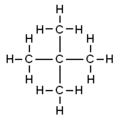- Pentane
-
n-Pentane 

 pentaneOther namesn-pentane
pentaneOther namesn-pentane
amyl hydride
Skellysolve AIdentifiers CAS number 109-66-0 
PubChem 8003 ChemSpider 7712 
UNII 4FEX897A91 
DrugBank DB03119 ChEBI CHEBI:37830 
ChEMBL CHEMBL16102 
RTECS number RZ9450000 Jmol-3D images Image 1 - CCCCC
Properties Molecular formula C5H12 Molar mass 72.15 g/mol Appearance Colourless liquid Density 0.626 g/mL, liquid Melting point −129.8 °C (143 K)
Boiling point 36.1 °C (308 K)
Solubility in water 0.04 g/L (20 °C)[1] Acidity (pKa) ~45 Viscosity 0.240 cP at 20 °C Hazards MSDS External MSDS R/S statement R: R12, R51/53, R65,
R66, R67
S: (S2), S9, S16,
S29, S33, S61, S62Main hazards Highly flammable (F+)
Harmful (Xn)
Dangerous for the environment (N)NFPA 704 Flash point – 49 °C Autoignition
temperature260 °C Related compounds Related alkanes Butane, Isopentane,
Neopentane, HexaneRelated compounds Cyclopentane Supplementary data page Structure and
propertiesn, εr, etc. Thermodynamic
dataPhase behaviour
Solid, liquid, gasSpectral data UV, IR, NMR, MS  (verify) (what is:
(verify) (what is:  /
/ ?)
?)
Except where noted otherwise, data are given for materials in their standard state (at 25 °C, 100 kPa)Infobox references Pentane is an organic compound with the formula C5H12 — that is, an alkane with five carbon atoms. The term may refer to any of three structural isomers, or to a mixture of them: in the IUPAC nomenclature, however, pentane means exclusively the n-pentane isomer; the other two being called "methylbutane" and "dimethylpropane". Cyclopentane is not an isomer of pentane.
Pentanes are components of some fuels and are employed as specialty solvents in the laboratory. Their properties are very similar to those of butanes and hexanes.
Contents
Isomers
Common name normal pentane
unbranched pentane
n-pentaneisopentane neopentane IUPAC name pentane methylbutane dimethylpropane Molecular
diagram
Skeletal
diagram


Industrial uses
Pentane is one of the primary blowing agents used in the production of polystyrene foam.
Because of its low boiling point, low cost, and relative safety, pentane is used as a working medium in geothermal power stations. It is added into some refrigerant blends as well.
Laboratory use
Pentanes are relatively inexpensive and are the most volatile alkanes that are liquid at room temperature, so they are often used in the laboratory as solvents that can be conveniently evaporated. However, because of their nonpolarity and lack of functionality, they can only dissolve non-polar and alkyl-rich compounds. Pentanes are miscible with most common nonpolar solvents such as chlorocarbons, aromatics, and ethers. They are also often used in liquid chromatography.
Physical properties
Melting point (MP), boiling point (BP) and density of pentanes[2] Isomer MP (°C) BP (°C) Density (g/L) n-pentane −129.8 36.0 621 isopentane −159.9 27.7 616 neopentane −16.6 9.5 586 The boiling points of the pentane isomers range from about 9 to 36 °C. As is the case for other alkanes, the more branched isomers tend to have lower boiling points.
The same trend normally holds for the melting points of alkane isomers, and indeed that of isopentane is 30 °C lower than that of n-pentane. However, the melting point of neopentane, the most heavily branched of the three, is 100 °C higher that of isopentane. The anomalously high melting point of neopentane has been attributed to the better solid-state packing assumed to be possible with its tetrahedral molecule; but this explanation has been challenged on account of it having a lower density than the other two isomers.[2]
The branched isomers are more stable (have lower heat of formation and heat of combustion) than normal pentane. The difference is 1.8 kcal/mol for isopentane, and 5 kcal/mol for neopentane.[3]
Rotation about two central single C-C bonds of n-pentane produces four different conformations.[4]
Reactions
All pentane isomers burn with oxygen to form carbon dioxide and water:
- C5H12 + 8 O2 → 5 CO2 + 6 H2O
As with other hydrocarbons, pentanes undergo free radical chlorination:
- C5H12 + Cl2 → C5H11Cl + HCl
Such reactions are unselective; with n-pentane, the result is a mixture of the 1-, 2-, and 3-chloropentanes, as well as more highly chlorinated derivatives. Other radical halogenations can also occur.
While n-butane is the conventional feedstock in the production of maleic anhydride, n-pentane is also a substrate:
- CH3CH2CH2CH2CH3 + 5 O2 → C2H2(CO)2O + 5 H2O + CO2
References
- ^ Record of n-Pentane in the GESTIS Substance Database from the IFA, accessed on 19 April 2011
- ^ a b James Wei (1999), Molecular Symmetry, Rotational Entropy, and Elevated Melting Points. Ind. Eng. Chem. Res., volume 38 issue 12, pp. 5019–5027 doi:10.1021/ie990588m
- ^ From the values listed at Standard enthalpy change of formation (data table).
- ^ Roman M. Balabin (2009). "Enthalpy Difference between Conformations of Normal Alkanes: Raman Spectroscopy Study of n-Pentane and n-Butane". J. Phys. Chem. A 113 (6): 1012. doi:10.1021/jp809639s. PMID 19152252.
External links
- International Chemical Safety Card 0534 at ILO.org
- NIOSH Pocket Guide to Chemical Hazards at CDC.gov
- Material safety data sheet for Pentane at Ox.ac.uk
- Phytochemical data for pentane at Ars-grin.gov
Alkanes Higher alkanes · List of alkanesCategories:- Alkanes
- Hydrocarbon solvents
Wikimedia Foundation. 2010.



